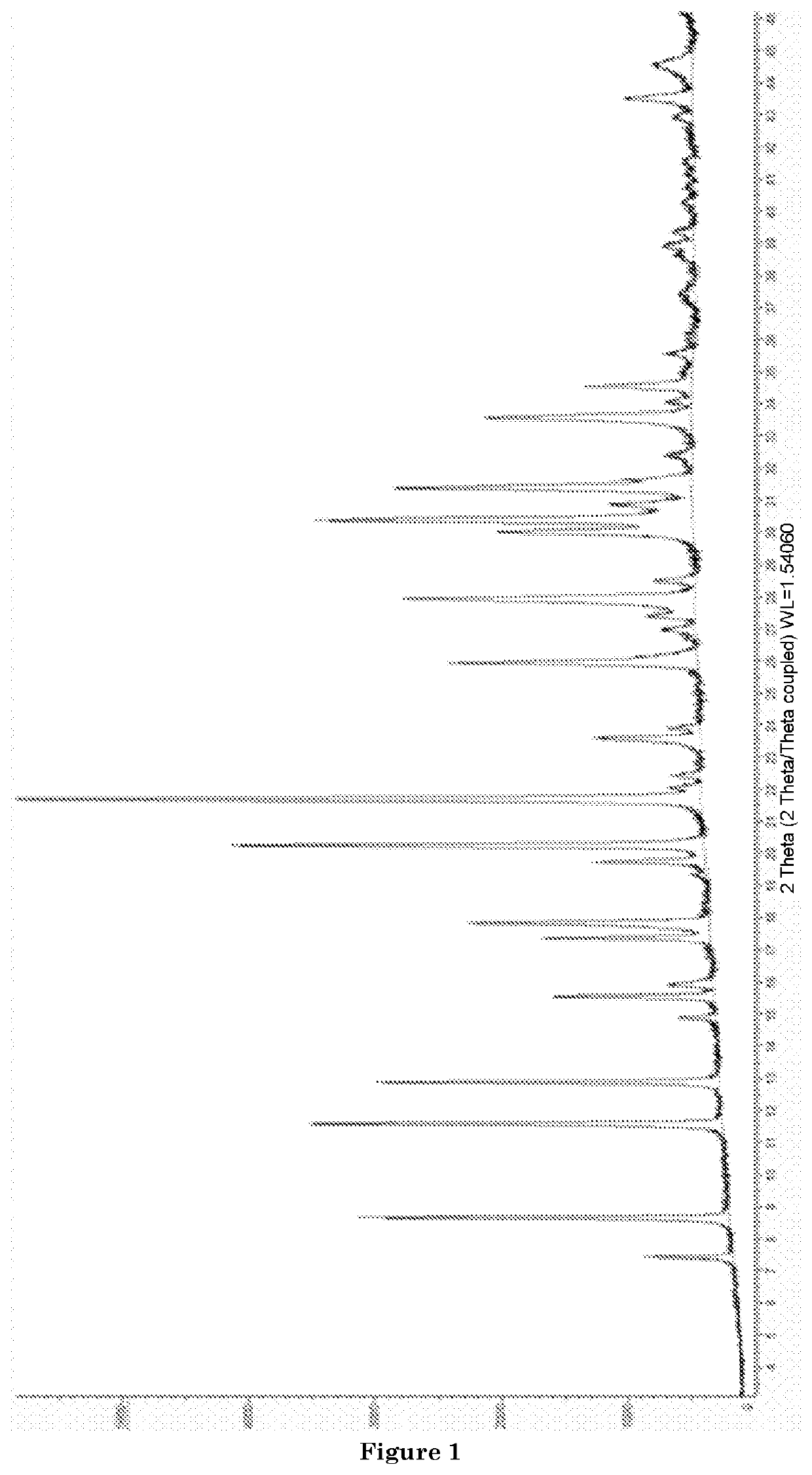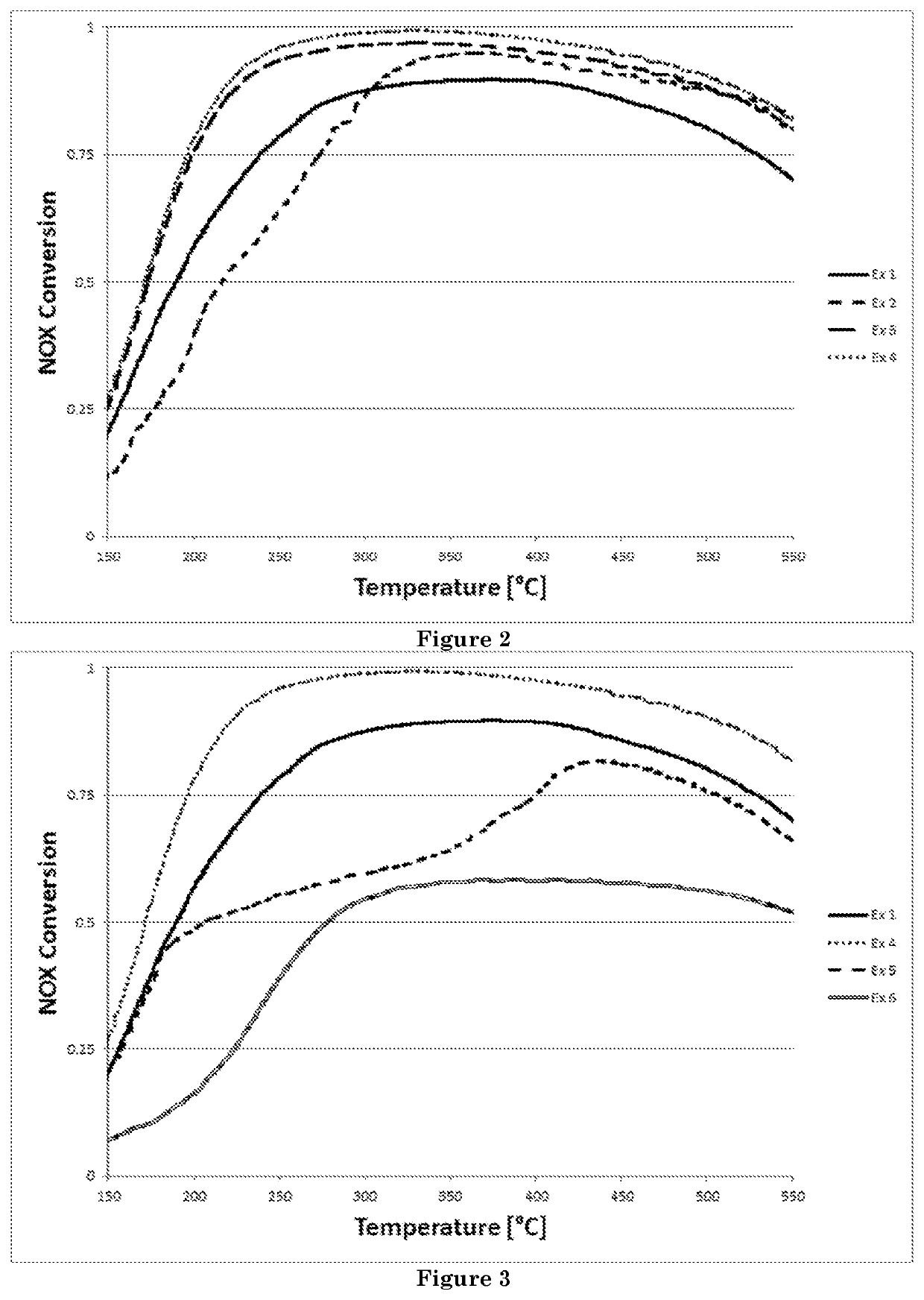Direct Synthesis of a Microporous Aluminosilicate Material Having an AFX Structure and Comprising Copper, and Use of said Material
- Summary
- Abstract
- Description
- Claims
- Application Information
AI Technical Summary
Benefits of technology
Problems solved by technology
Method used
Image
Examples
example 1 (
not in Accordance with the Invention)
[0060]In this example, a Cu-exchanged SSZ-16 zeolite is synthesized according to the prior art. In this example, the copper is introduced by ion exchange.
[0061]Mixing Step
[0062]17.32 g of sodium hydroxide are dissolved in 582.30 g of deionized water, with stirring (300 rpm) and at ambient temperature. 197.10 g of sodium silicate are added to this solution and the mixture is homogenized with stirring (300 rpm) at ambient temperature. Then, 9.95 g of NaY CBV100 zeolite are added with stirring (300 rpm) and this is thus continued until the zeolite has dissolved. 43.67 g of the DABCO-C4 structuring agent are dissolved in the solution obtained and it is thus homogenized with stirring (450 rpm) for 30 minutes, at ambient temperature.
[0063]The reaction mixture has the following molar composition: 100 SiO2: 1.67 Al2O3: 50 Na2O: 10 DABCO-C4: 4000 H2O
[0064]Maturation Step
[0065]The reaction mixture obtained in the mixing step is kept at ambient temperature ...
example 2 (
not in Accordance with the Invention)
Synthesis of an SSZ-16 Zeolite with Direct Incorporation of Cu Using a Tetraethylenepentamine (TEPA) Complexing Agent
[0078]Mixing Step
[0079]2.64 g of sodium hydroxide dissolved in 77.92 g of deionized water, with stirring (300 rpm) and at ambient temperature. 30.06 g of sodium silicate are added to this solution and the mixture is homogenized with stirring (300 rpm) at ambient temperature. Then, 1.52 g of NaY CBV100 zeolite are poured into the solution previously obtained with stirring at 300 rpm and this is thus continued until the zeolite has dissolved. This solution is referred to as solution 2-1.
[0080]0.14 g of copper sulfate are dissolved in 10.94 g of deionized water with stirring for 10 minutes then 0.11 g of tetraethylenepentamine (TEPA) are dissolved in this copper solution. Then, the solution is poured into the solution 2-1 with stirring at 300 rpm. The mixture is homogenized for 10 min with stirring (300 rpm) and then 6.67 of the DABCO...
example 3 (
in Accordance with the Invention)
[0089]In this example, an SSZ-16 zeolite is synthesized with incorporation of the copper in two steps: first step in the synthesis of the zeolite using a Cu-Tetraethylenepentamine (TEPA) complex followed by a second step after the calcination of the zeolite by ion exchange with the [Cu(NH3)4](NO3)2 complex.
[0090]Mixing Step
[0091]2.64 g of sodium hydroxide dissolved in 77.92 g of deionized water, with stirring (300 rpm) and at ambient temperature. 30.06 g of sodium silicate are added to this solution and the mixture is homogenized with stirring at 300 rpm at ambient temperature. Then, 1.52 g of NaY CBV100 zeolite are poured into the solution previously obtained with stirring at 300 rpm and this is thus continued until the zeolite has dissolved. This solution is referred to as solution 2-1.
[0092]0.05 g of copper sulfate are dissolved in 10.94 g of deionized water with stirring for 10 minutes then 0.05 g of tetraethylenepentamine (TEPA) are dissolved in...
PUM
| Property | Measurement | Unit |
|---|---|---|
| Temperature | aaaaa | aaaaa |
| Temperature | aaaaa | aaaaa |
| Temperature | aaaaa | aaaaa |
Abstract
Description
Claims
Application Information
 Login to View More
Login to View More - Generate Ideas
- Intellectual Property
- Life Sciences
- Materials
- Tech Scout
- Unparalleled Data Quality
- Higher Quality Content
- 60% Fewer Hallucinations
Browse by: Latest US Patents, China's latest patents, Technical Efficacy Thesaurus, Application Domain, Technology Topic, Popular Technical Reports.
© 2025 PatSnap. All rights reserved.Legal|Privacy policy|Modern Slavery Act Transparency Statement|Sitemap|About US| Contact US: help@patsnap.com


